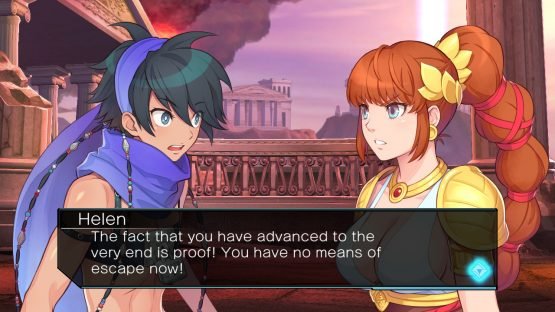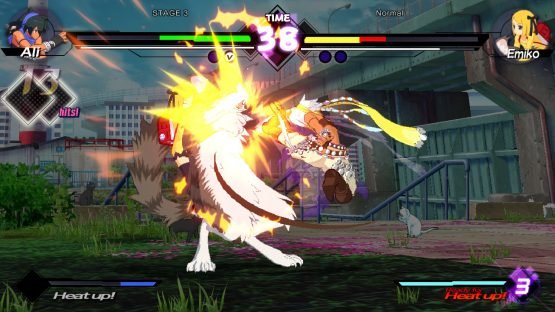Blade Strangers Review (Switch)
It feels like all I have played this year are crossover titles, of varying levels of success and narrative insanity. No matter how many absurd narratives I played though, I was still really excited for Nicalis’ Blade Strangers, if only because Gunvolt and Shovel Knight were on the roster. However, how did the accessible fighting game shape up on release?
The plot of the game unfolds over each character’s individual story (with certain characters of the roster blocked out until you have finished the story of other characters (à la Tekken). The core narrative, however, is told through the means of a conversation between a set of robots called Motes and tells of an undefined battle in which worlds are being destroyed, and a ‘Blade Stranger’ that has been eliminated.
In a panic over their quickly approaching loss, the Motes come together to decide to bring together a set of ‘Strangers’ from different worlds and have them fight until one emerges as the next ‘Blade Stranger’ to continue fighting the grand battle (whatever that is). So, using a Transmitter, they bring all of these characters together, implanting false memories in the process to get them to fight each other. So, all good then, I guess.

Or maybe not all good. The set up of how the story unfolds in Blade Strangers does somewhat act to the detriment of the title. As you have pretty much the same story each time you play as any given character, this can become repetitive and would likely have benefitted far more from having a single mode where you play as multiple characters. This is a rather large problem with the game from a narrative standpoint, that diminishes the single player offering.
Blade Strangers is an unflinchingly accessible fighting game, by which I mean that all of the inputs have been heavily simplified, but that does not mean that depth has been sacrificed in this instance to achieve it. Every character has four basic attack buttons; light, medium, unique and special. These four buttons can achieve different attacks by pressing them at the same time as a direction, and both the light and medium buttons will auto-combo if pressed consecutively.
Add to this a few extra buttons such as a throw, mapped to ZR on the Switch, and a designated button for all of the super attacks (called Ultra Skills in this fighter, as they always have to be called something different), and you have all the trimmings of a traditional fighting game without any of those pesky inputs. Think of it as an anime fighter with Super Smash Bros style inputs for specials and you haven’t steered too far from the truth.

I have to add here that, as this is a cross over title, there are many different franchises on display here, and the developers have clearly taken care to make sure that the characters from these franchises have beautifully relevant movesets, whether it be Shovel Knight digging up gems launching the opponent with the initial part of the animation or extending his combos with the gems, or Isaac using various different tools from his arsenal in The Binding of Isaac, the attacks in this game are filled with cheeky nods and references.
Now, obviously, it wasn’t all going to be the simple, as I promised you depth earlier on and depth Blade Strangers has. The first and most noticeable feature in the title and the way it does combos specifically is the fact that the fact actively punishes the player with diminishing damage if they are repetitive in their use of attacks. So, you can use the Offensive Skill to dash into your opponent at what is the end of a combo string and repeat the exact same set of attacks, but you can get far greater damage from experimenting with different moves.
This feature, rather than being a burden, gives the more hardcore crowd like myself a reason to push and test new moves and combo strings in Training Mode, but still allows the more casual players to do basic combos, and all other attacks for that matter, far easier than most other fighters. Even the one button Ultra Skills have an element of strategy to them, with the ability to double tap the button to boost its power, meaning you can knowingly only use a single bar if you sense it might be blocked or use the two bar version after a solid hit confirm.

A word of warning for those coming into this game expecting a traditional anime fighter though; there are certain features and mechanics that are missing. For one, air guarding doesn’t exist, this isn’t a deal breaker by any means for me, but it did result in a solid period at the beginning where I kept being swatted out of the sky. The other missing thing is air dashing itself, which is significantly more jarring, and results in the overall movement feeling quite sluggish and odd. There are some characters that have an air special that operates somewhat like a dash, but they are often incredibly punishable.
Blade Strangers, because of this mix of casual-friendly accessible fighting on the base level, and deeper, complicated features as you scratch the surface, results in a thoroughly enjoyable fighting game for all skill levels. It does everything to a better than competent standard and even excels in a wide variety of areas of its gameplay. However, none of this would matter to a larger audience if the visuals weren’t up to the standard to entice in the casual players that its gameplay deserves.
Thankfully, the visuals on display here are absolutely lush, with some beautiful in-game sprites, visually arresting stages, and interesting character designs and redesigns (looking at you Shovel Knight), this title looks fantastic. In fact, the only time that the gorgeous visuals in this game look at all odd is when you see the game running on a big screen in which the pixels really start to show. In Handheld Mode on Switch, Blade Strangers looks absolutely incredible.

The only disappointment with the overall aesthetic of the game is in the music and sound design. The soundtrack is largely forgettable, apart from the character select music and that wonderful Shovel Knight remix from his stage, and with a fighting game a great set of music is needed to get you hyped up during matches. Also, the announcer isn’t particularly great either, feeling very lacklustre in comparison to other titles.
So, should you buy Blade Strangers? This all depends on what sort of game you’re looking for as this fills a very specific niche. It’s an incredibly fun and simple to play game, but with a remarkably short story mode (each character’s run is 15 minutes maximum, and are mostly the same) and slightly uninspired single player modes outside this. It’s a good game, and worth a try if you’re in the market for something new, just not good enough to compete amongst the big boys of the genre.
Will you be picking up Blade Strangers, or do you have it already? What do you think of the game? Let us know in the comments or on Twitter, and keep an eye on Rice Digital for more coverage of both fighting games and other Japanese titles.
- New Persona 5 Royal Trailer Introduces Kasumi And Special Edition Revealed - June 6, 2019
- New Bloodstained: Ritual of the Night Character Revealed Ahead Of Release - May 31, 2019
- Final Fantasy XIV: Shadowbringers Preview - May 29, 2019





